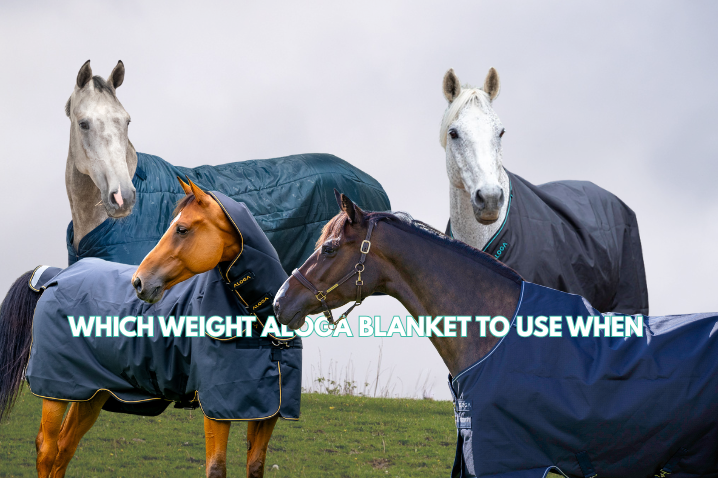Disclaimer
Every horse is individual. Factors such as age, breed, coat type, clipping, health, body condition, and environment all influence how they respond to temperature and weather. This guide is intended as a general suggestion only and should not replace careful observation and judgement by each horse’s owner or carer.
It is always the owner’s responsibility to monitor their horse’s comfort, adjust rugging as needed, and ensure their welfare under varying conditions.
As the seasons shift and temperatures begin to drop, we face the annual question: when does my horse actually need a blanket? Horses are naturally equipped to cope with colder weather, but understanding how and when to use the right weight of blanket can make a big difference to their comfort, health, and energy levels.
Drawing on research on equine thermoregulation, this guide outlines how temperature, coat type, and environment interact and how Aloga Equestrian blankets can support your horse through every condition.
Understanding How Horses Regulate Temperature
Horses maintain a steady core temperature of around 38 °C, using mechanisms like vasodilation, shivering, and sweating to conserve or release heat. The concept of the thermoneutral zone is the range of ambient temperatures in which a horse doesn’t need to expend extra energy to keep warm or cool.
For most horses with a natural winter coat, this comfort zone lies roughly between 5 °C and 25 °C. Within that range, the body can regulate itself efficiently. Below about 5 °C, a horse must burn more energy to stay warm—so insulation from a well-fitted, breathable rug can help maintain comfort without overheating.
However, no two horses are the same. Age, coat thickness, clipping, body condition, health, and even shelter availability all affect how much warmth your horse requires. The goal is always balance: enough insulation to conserve warmth without trapping excess heat or moisture.
Equally rain fall levels, humidity or wind speeds can impact your horse’s ability to thermoregulate as ambient temperatures drop.
Choosing the Right Aloga Blanket
To make things easier, we’ve created a temperature-based guide to suggest the appropriate Aloga Equestrian blanket. Use this as a starting point, and adjust based on your horse’s condition, the weather, and your local environment.
Above 10 °C

Most unclipped horses are comfortable unrugged at these temperatures, needing only protection from wind or rain. Clipped or fine-coated horses may benefit from a lightweight layer such as the Aloga Pro Turnout 0g, Aloga Turnout 2.0 0g, or Aloga Turnout 2.0 150g for minimal, waterproof coverage.
5 – 10 °C

As temperatures drop, even natural coats can benefit from light insulation overnight or waterproof protection in exposed paddocks. For clipped or senior horses, a consistent lightweight rug like the Aloga Turnout 2.0 150g provides the perfect balance between warmth and breathability.
0 – 5 °C

When temperatures dip towards freezing, medium insulation is usually ideal. Horses with thick coats may cope well with a Aloga Turnout 2.0 150g, while clipped or poor-doing horses often prefer added coverage such as the Aloga Pro Turnout 200g & Hood or a Aloga Pro Turnout 0g paired with an Aloga Liner 200g.
–5 – 0 °C

In sub-zero conditions, a heavy rug or layered system is recommended for clipped, thinned skinned or older horses. The Aloga Pro Turnout 350g & Hood or Aloga Pro Turnout 0g paired with the Aloga Liner 350g provide superior insulation while maintaining breathability.
Below –5 °C or in severe wind and precipitation

These are the toughest conditions, where maximum warmth and protection are essential. For full coverage, layer the Aloga Pro Turnout 200g & Hood with an Aloga Liner 200g to create a robust dual-layer system that keeps body heat in and moisture out. Horses that are stabled indoors, the Pro Stable Blanket 400g is the best option and can be adjusted using the liner or hood loops.
Pro Blanketing Tips
- Remember the Thermoneutral Zone: Most horses are comfortable between 5 °C and 25 °C. Below that, a blanket helps conserve energy.
- Wind and Wet Amplify Cold: A dry, still 0 °C day is far easier on a horse than a wet, windy one at the same temperature. Choose blankets with waterproof, breathable materials whenever possible.
- Check Daily: Run your hand beneath the blanket; your horse should feel dry and comfortably warm, never damp, sweating or hot.
- Use Layering Smartly: The Aloga liner system allows flexible insulation when temperatures fluctuate throughout the day.
- Watch for Signs: Cold horses may shiver or stand hunched; overheated ones sweat or become restless. Adjust your blanket choices accordingly.
Comfort based Experience
At Aloga Equestrian, we design blanket that combine real-world experience with practicality. Every detail from our shine enhancing lining to our detachable hoods are built to maintain comfort through changing conditions.
This guide is not a one-size-fits-all formula but recommendations grounded in research and observation. Horses, like people, have individual needs. The best approach is to use this temperature chart as a baseline, observe your horse closely, and adjust as required.
By understanding thermoregulation and applying it with the right Aloga blanket, you’re not just keeping your horse warm, you’re helping them stay comfortable, aiding coat health, and wellbeing.

